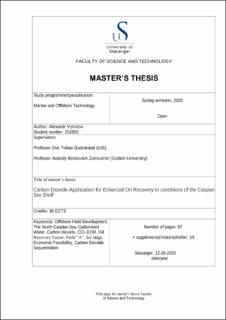| dc.contributor.advisor | Gudmestad, Ove Tobias | |
| dc.contributor.author | Vyrodov, Alexandr | |
| dc.date.accessioned | 2020-09-18T13:13:42Z | |
| dc.date.available | 2020-09-18T13:13:42Z | |
| dc.date.issued | 2020-06-12 | |
| dc.identifier.uri | https://hdl.handle.net/11250/2678546 | |
| dc.description | Master's thesis in Offshore technology | en_US |
| dc.description.abstract | CO2 injection into the hydrocarbon-bearing reservoirs is considered as one of the most promising technologies for enhanced oil recovery. This technology has gained significant attention due to its economic benefits as there has been an increasing amount of carbon dioxide sources in various branches of industry. Besides incremental oil recovery extraction, the CO2 injected remains sequestrated in underground formations. Thus, such a technology mitigates carbon dioxide emissions in an economically feasible way, and an additional oil volume production accompanies it. State of the art science displays two primary methods for carbon dioxide application in an enhanced oil recovery process; these are gaseous CO2 injection and carbonated water injection.
The current study focuses on CO2-EOR technology for offshore oil Field “A” located on the North Caspian Sea shelf. Each of the two methods mentioned above was analyzed to determine the potential oil recovery factor as a result of carbon dioxide injection. Moreover, possible CO2 sources and transportation routes were also considered. The preliminary assessment revealed that injection of 5 % carbonated water (CWI) displays the most optimal economic and technological parameters.
The investigation study also includes a field development concept designed for carbonated water injection based on Field “A’s” existing infrastructure. The Arctic-related environmental conditions of the region were considered to develop a robust technological flowsheet. Within the concept development offshore and onshore pipelines were designed, as well as ejector units for carbon dioxide dissolution in seawater; equipment assembly and detailed drawings were completed. Subsea pipeline protection against ice ridges is analyzed.
The primary purpose of the thesis is to formulate a methodology for preparing an estimate for the applicability of carbon dioxide injection in an offshore enhanced oil recovery process. | en_US |
| dc.language.iso | eng | en_US |
| dc.publisher | University of Stavanger, Norway | en_US |
| dc.relation.ispartofseries | Masteroppgave/UIS-TN-IMBM/2020; | |
| dc.rights | Attribution-NoDerivatives 4.0 Internasjonal | * |
| dc.rights.uri | http://creativecommons.org/licenses/by-nd/4.0/deed.no | * |
| dc.subject | offshore teknologi | en_US |
| dc.subject | undervannsteknologi | en_US |
| dc.subject | offshore field development | en_US |
| dc.subject | carbon dioxide | en_US |
| dc.subject | The North Caspian Sea | en_US |
| dc.subject | carbonated water | en_US |
| dc.subject | enhanced oil recovery | en_US |
| dc.subject | EOR | en_US |
| dc.title | Carbon dioxide application for Enhanced Oil Recovery in conditions of the Caspian Sea shelf | en_US |
| dc.type | Master thesis | en_US |
| dc.subject.nsi | VDP::Teknologi: 500::Marin teknologi: 580::Offshoreteknologi: 581 | en_US |

